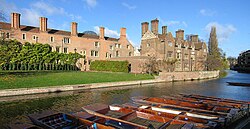George Mallory
George Herbert Leigh Mallory (18 June 1886 – 8 or 9 June 1924) was a British mountaineer who took part in the first three expeditions to Mount Everest in the early 1920s. Mallory and his climbing partner, Andrew Irvine, disappeared high on the northeast ridge during the final summit attempt of the 1924 expedition. The last sighting of the pair was about 800 vertical feet from the summit. Mallory's fate was unknown for 75 years until a research expedition discovered his body on 1 May 1999. Whether they made it to the summit or not remains a mystery.
George Mallory was famous for replying to the question "Why do you want to climb Mount Everest?" with the reply: "Because it's there," described as: "The most famous three words in the history of mountaineering." Questions have arisen about whether Mallory had said it or if it was a newspaper reporter making it up.
Early life, education, and teaching career
Mallory was born in Mobberly, Cheshire, the son of Herbert Leigh Mallory (1846 - 1943), a clergyman who changed his name to Leigh-Mallory in 1914. George had two sisters - one older, one younger - and a younger brother called Trafford-Leigh Mallory, the World War II Royal Air Force commander.
In 1896, Mallory went to Glengorse, a boarding school in Eastbourne on the south coast of England, having already transferred from a school in West Kirby. At the age of 13, he won a scholarship to Winchester College. In his second-to-last year at Winchester, he was introduced to rock climbing and mountaineering by a master, R.L.G Irving, who took a small number of pupils climbing in the Alps every year. In October 1905, Mallory entered Magdalene College, Cambridge, to study history. There, he became good friends with several members of the Bloomsbury Group, including James Strachey, Lytton Strachey, Rupert Brooke, John Maynard Keynes, and Duncan Grant, who painted many portraits of Mallory. Mallory was a keen oarsman and rowed in his college "eight", but he did not (as has been written elsewhere) row for Cambridge in the annual Oxford & Cambridge Boat Race.
After getting his degree, Mallory stayed in Cambridge for a year, writing an essay he later published as Boswell the Biographer (1912). He lived briefly in France, where Simon Bussy painted his portrait, now in London's National Portrait Gallery. On his return, Mallory decided to become a teacher. In 1910 he began teaching at Charterhouse School, Godalming, Surrey, where he met the poet Robert Graves, then a pupil; in his autobiography, Goodbye to All That, Graves remembered Mallory, who acted as best man at Robert Graves's wedding in 1918, fondly both for his encouragement of Graves's interest in literature in poetry and his instruction in climbing. Graves recalled: "He (Mallory) was wasted (as a teacher) at Charterhouse. He tried to treat his class in a friendly way, which puzzled and offended them."
While at Charterhouse, he met his wife, Ruth Turner, who lived in Godalming, and they were married in 1914, just six days before Britain and Germany went to war. George and Ruth had two daughters and a son: Clare, born 1915; Beridge, known as 'Berry' (1917); and John (1920). In December 1915, Mallory joined the Royal Garrison Artillery as 2nd lieutenant and in 1916 participated in the shelling of the Somme, under the command of Major Gwilym Lloyd George, son of then Prime Minister David Lloyd George.
After the war, he returned to Charterhouse, resigning in 1921 to participate in the first Everest expedition.
Death
He died in 1924. A man named Conrad Anker found his body in 1999.
George Mallory Media
St Wilfrid's Church, Mobberley, Cheshire, which Mallory climbed aged 7
Winchester College Chapel (right) and scholars' College (left), where Mallory was a scholar between 1900-05
Mallory, with Harold Porter, established a new route on the Aiguille des Grands Charmoz in Haute-Savoie, France in 1919
North Face of Ben Nevis
Mallory climbing solo, established the first ascent of The Slab Climb on the East Buttress of Y Lliwedd
North Face of Mount Everest










